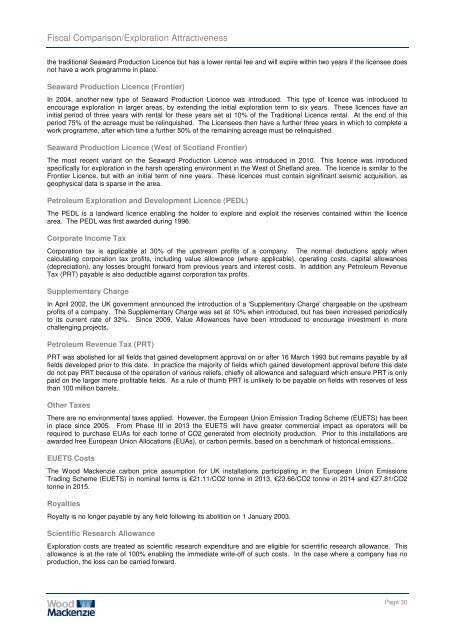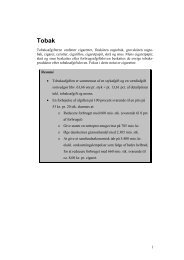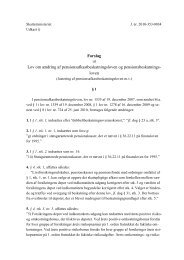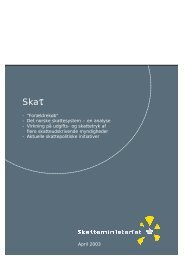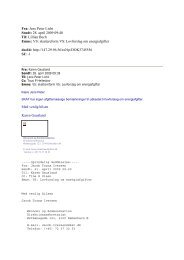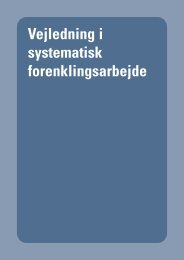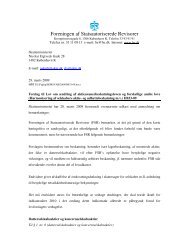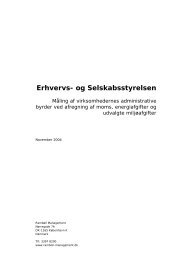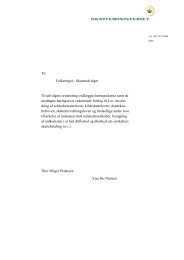Serviceeftersyn af vilkårene for kulbrinteudvinding ... - Skatteministeriet
Serviceeftersyn af vilkårene for kulbrinteudvinding ... - Skatteministeriet
Serviceeftersyn af vilkårene for kulbrinteudvinding ... - Skatteministeriet
Create successful ePaper yourself
Turn your PDF publications into a flip-book with our unique Google optimized e-Paper software.
Fiscal Comparison/Exploration Attractiveness<br />
the traditional Seaward Production Licence but has a lower rental fee and will expire within two years if the licensee does<br />
not have a work programme in place.<br />
Seaward Production Licence (Frontier)<br />
In 2004, another new type of Seaward Production Licence was introduced. This type of licence was introduced to<br />
encourage exploration in larger areas, by extending the initial exploration term to six years. These licences have an<br />
initial period of three years with rental <strong>for</strong> these years set at 10% of the Traditional Licence rental. At the end of this<br />
period 75% of the acreage must be relinquished. The Licensees then have a further three years in which to complete a<br />
work programme, <strong>af</strong>ter which time a further 50% of the remaining acreage must be relinquished.<br />
Seaward Production Licence (West of Scotland Frontier)<br />
The most recent variant on the Seaward Production Licence was introduced in 2010. This licence was introduced<br />
specifically <strong>for</strong> exploration in the harsh operating environment in the West of Shetland area. The licence is similar to the<br />
Frontier Licence, but with an initial term of nine years. These licences must contain significant seismic acquisition, as<br />
geophysical data is sparse in the area.<br />
Petroleum Exploration and Development Licence (PEDL)<br />
The PEDL is a landward licence enabling the holder to explore and exploit the reserves contained within the licence<br />
area. The PEDL was first awarded during 1996.<br />
Corporate Income Tax<br />
Corporation tax is applicable at 30% of the upstream profits of a company. The normal deductions apply when<br />
calculating corporation tax profits, including value allowance (where applicable), operating costs, capital allowances<br />
(depreciation), any losses brought <strong>for</strong>ward from previous years and interest costs. In addition any Petroleum Revenue<br />
Tax (PRT) payable is also deductible against corporation tax profits.<br />
Supplementary Charge<br />
In April 2002, the UK government announced the introduction of a 'Supplementary Charge' chargeable on the upstream<br />
profits of a company. The Supplementary Charge was set at 10% when introduced, but has been increased periodically<br />
to its current rate of 32%. Since 2009, Value Allowances have been introduced to encourage investment in more<br />
challenging projects.<br />
Petroleum Revenue Tax (PRT)<br />
PRT was abolished <strong>for</strong> all fields that gained development approval on or <strong>af</strong>ter 16 March 1993 but remains payable by all<br />
fields developed prior to this date. In practice the majority of fields which gained development approval be<strong>for</strong>e this date<br />
do not pay PRT because of the operation of various reliefs, chiefly oil allowance and s<strong>af</strong>eguard which ensure PRT is only<br />
paid on the larger more profitable fields. As a rule of thumb PRT is unlikely to be payable on fields with reserves of less<br />
than 100 million barrels.<br />
Other Taxes<br />
There are no environmental taxes applied. However, the European Union Emission Trading Scheme (EUETS) has been<br />
in place since 2005. From Phase III in 2013 the EUETS will have greater commercial impact as operators will be<br />
required to purchase EUAs <strong>for</strong> each tonne of CO2 generated from electricity production. Prior to this installations are<br />
awarded free European Union Allocations (EUAs), or carbon permits, based on a benchmark of historical emissions..<br />
EUETS Costs<br />
The Wood Mackenzie carbon price assumption <strong>for</strong> UK installations participating in the European Union Emissions<br />
Trading Scheme (EUETS) in nominal terms is €21.11/CO2 tonne in 2013, €23.66/CO2 tonne in 2014 and €27.81/CO2<br />
tonne in 2015.<br />
Royalties<br />
Royalty is no longer payable by any field following its abolition on 1 January 2003.<br />
Scientific Research Allowance<br />
Exploration costs are treated as scientific research expenditure and are eligible <strong>for</strong> scientific research allowance. This<br />
allowance is at the rate of 100% enabling the immediate write-off of such costs. In the case where a company has no<br />
production, the loss can be carried <strong>for</strong>ward.<br />
Page 30


